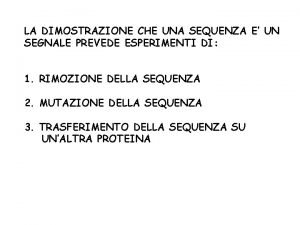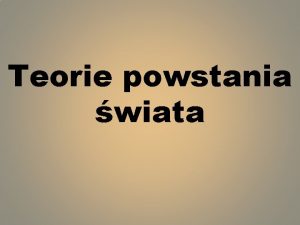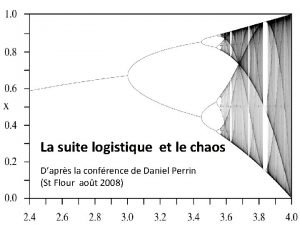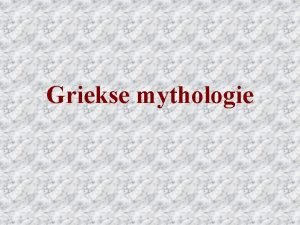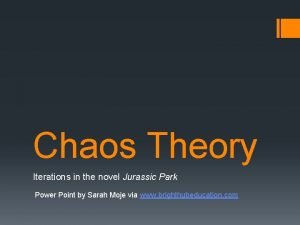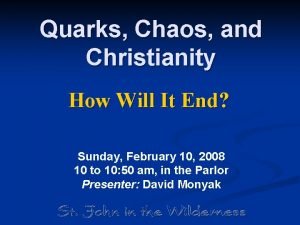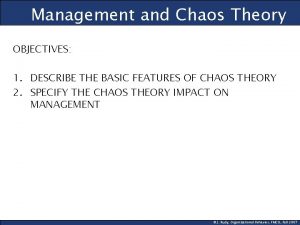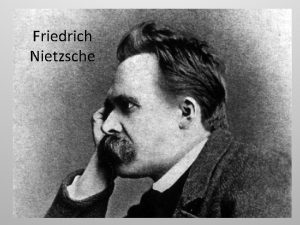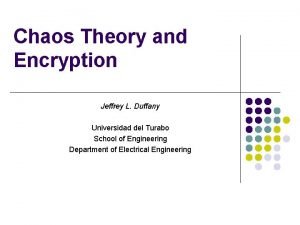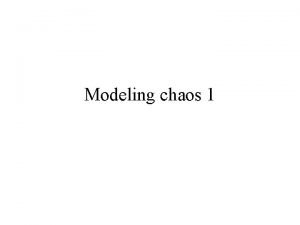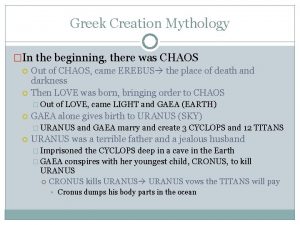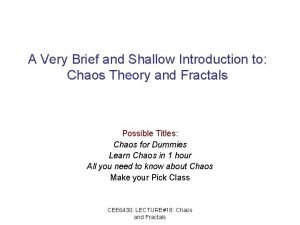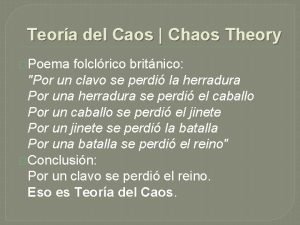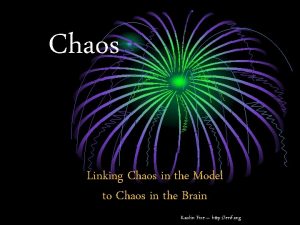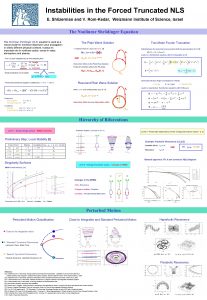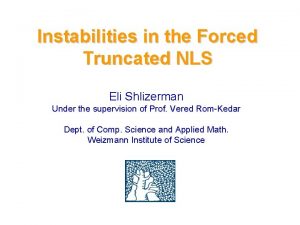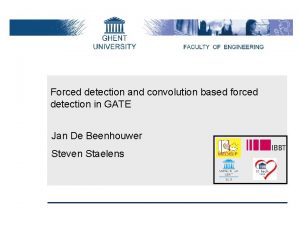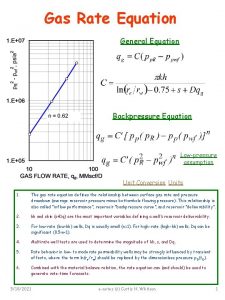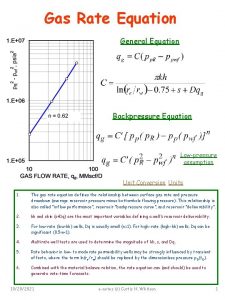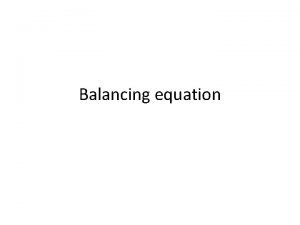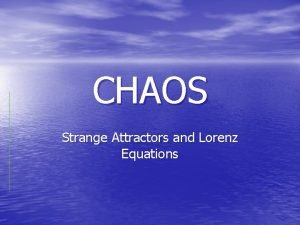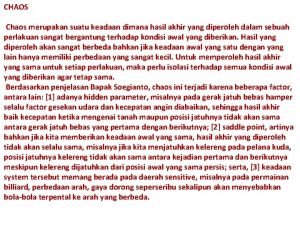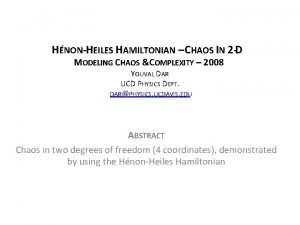Mechanisms of chaos in the forced NLS equation



































- Slides: 35

Mechanisms of chaos in the forced NLS equation Eli Shlizerman Vered Rom-Kedar Weizmann Institute of Science eli. shlizerman@weizmann. ac. il http: //www. wisdom. weizmann. ac. il/~elis/

The autonomous NLS equation • Boundary • Periodic • Even B(x+L, t) = B(x, t) B(-x, t) = B(x, t) • Parameters • Wavenumber k = 2π / L • Forcing Frequency Ω 2

Integrals of motion • The “Particle Number”: • The “Energy”: • The “Perturbation”:

The problem Classify instabilities in the NLS equation Time evolution near plane wave

Solitons • Solitary wave • Permanent shape B (x , t) = g (x) • Traveling wave solution B (x , t) = g (x - vt) • Localized g (r) = 0 r →±∞ • Particle like • Preserved under collisions

Plane wave solution Bh Re(B(0, t)) Bh θ₀ θ₀ Bpw Im(B(0, t)) Heteroclinic Orbits!

Modal equations • Consider two mode Fourier truncation B(x , t) = c (t) + b (t) cos (kx) • Substitute into the unperturbed eq. : [Bishop, Mc. Laughlin, Ercolani, Forest, Overmann]

General Action-Angle Coordinates • For b≠ 0 , consider the transformation: • Then the systems is transformed to: • We can study the structure of [Kovacic]

The Hierarchy of Bifurcations Local Stability for I < 2 k 2 Fixed Point x=0 y=0 x=±x 2 y=0 Stable I>0 I > ½k 2 Unstable I > ½ k 2 - Fixed points in (x, y) are circles in 4 dimensional space

Perturbed motion classification near the plane wave • “Standard” dyn. phenomena • Homoclinic Chaos, Elliptic Circles • Special dyn. phenomena • PR, ER, HR I • Close to the integrable motion H 0 Dashed – Unstable Solid – Stable

Analogy between ODE and PDE I ODE y x PDE H 0 Bpw=Plane wave

Analogy between ODE and PDE I ODE y x PDE H 0 +Bh=Homoclinic Solution

Analogy between ODE and PDE I ODE y x PDE -Bh=Homoclinic Solution H 0

Analogy between ODE and PDE I ODE y x PDE H 0 +Bsol=Soliton (X=L/2)

Analogy between ODE and PDE I ODE y x PDE +Bsol=Soliton (X=0) H 0

I Numerical simulations - Surface plot I H 0 H 0

B plane plot

EMBD

I-γ plot

Conclusions • Three different types of chaotic behavior and instabilities in Hamiltonian perturbations of the NLS are described. • The study reveals a new type of behavior near the plane wave solution: Parabolic Resonance. • Possible applications to Bose-Einstein condensate.

Characterization Tool • An input: Bin(x, t) – can we place this solution within our classification? • Quantitative way for classification (tool/measure) HC - O(ε), HR - O(ε 1/2), PR - O(ε 1/3) • Applying measure to PDE results

The measure: σmax y x Measure: σmax = std( |B 0 j| max)

σmax PDF for fixed ε

σmax dependence on ε

Future Work • Capturing the system into PR by variation of the forcing • Instabilities in the BEC • Resonant surface waves

Thank you!

Summary • We analyzed the modal equations with the “Hierarchy of Bifurcations” • Established the analogy between ODE and PDE • Numerical simulations of instabilities • Characterization tool

I Analogy between ODE and PDE y H 0 x -Bsol=Soliton (X=L/2) Bpw=Plane wave -Bh=Homoclinic Solution +Bsol=Soliton (X=0) +Bh=Homoclinic Solution

The Hierarchy of Bifurcations We can construct the EMBD for all fixed points in the model:

Previous experiments D. Mc. Laughlin, K. Mc. Laughlin, Overmann, Cai

Evenness condition Without evenness: • For small L - the solutions are correlated D. Mc. Laughlin, K. Mc. Laughlin, Overmann, Cai

Local Stability • Plane wave: B(0, t)= c(t) • Introduce x-dependence of small magnitude B (x , t) = c(t) + b(x, t) • Plug into the integrable equation and solve the linearized equation. From dispersion relation get instability for: 0 < k 2 < |c|2

Local Stability • But k is discretized by L so kj = 2πj/L for j = 0, 1, 2… (j - number of LUMs) • Substitute to 0 < k 2 < |c|2 and get 2πj/L < |c| < 2π(j+1)/L • As we increase the amplitude the number of LUMs grows.

Validity of the model • For plane wave (b=0): • Substituting the condition for |c| for 1 LUM: 2πj/L < |c| < 2π(j+1)/L j=1 • Then the 2 model is plausible for I < 2 k 2

Analogy between ODE and PDE • Constants of motion • The solution
 Nls metatron
Nls metatron Sequenza segnale
Sequenza segnale Na początku był chaos biblia
Na początku był chaos biblia Bitterrezeptoren
Bitterrezeptoren Monsters in the bible
Monsters in the bible Fonction logistique chaos
Fonction logistique chaos Stamboom poseidon
Stamboom poseidon Chaos greek mythology family tree
Chaos greek mythology family tree Animals that represent chaos
Animals that represent chaos Copyright chaos
Copyright chaos Jurassic park fractal
Jurassic park fractal Chaos sound test
Chaos sound test Big crunch
Big crunch Chaos theory management
Chaos theory management Six degrees of separation themes
Six degrees of separation themes Nihilists
Nihilists Chaos theory and cryptology
Chaos theory and cryptology Chaos ruled ok in the classroom
Chaos ruled ok in the classroom Fractals and chaos
Fractals and chaos Drzewo genealogiczne uranos i gaja
Drzewo genealogiczne uranos i gaja Chaos in greek mythology
Chaos in greek mythology Callbacks
Callbacks Chaos in de klas
Chaos in de klas Aip chaos
Aip chaos Antipathy adjective
Antipathy adjective Greek goddesses of chaos
Greek goddesses of chaos Tyche family tree
Tyche family tree Cauliflower chaos fractals every
Cauliflower chaos fractals every Generally restful like the horison where the sky meets land
Generally restful like the horison where the sky meets land Poema por un clavo se perdio una herradura
Poema por un clavo se perdio una herradura After feeding several quarters into the gumball machine
After feeding several quarters into the gumball machine In the beginning there was chaos
In the beginning there was chaos Report chaos
Report chaos What did the molten sea represent
What did the molten sea represent Standish group chaos report 2020
Standish group chaos report 2020 Chaos report
Chaos report

